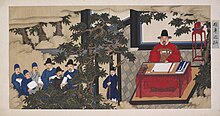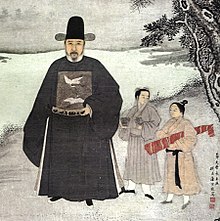
Back Funcionarios letrados Spanish دانشپژوه-رسمی Persian Fonctionnaire érudit French Pejabat-cendekiawan ID Funzionario-letterato Italian 士大夫 Japanese 사대부 Korean Literati (klasse) Dutch Burocrata acadêmico Portuguese Učenjak-službenik Serbo-Croatian
This article needs additional citations for verification. (April 2020) |
| Scholar-official | |||||||
|---|---|---|---|---|---|---|---|
 Painting that depicts the career of a civil servant. The career path starts with passing the civil service examinations (left side) and progresses to a high position in the government (right side). | |||||||
| Chinese name | |||||||
| Traditional Chinese | 士大夫 | ||||||
| |||||||
| Vietnamese name | |||||||
| Vietnamese alphabet | Sĩ đại phu | ||||||
| Chữ Hán | 士大夫 | ||||||
| Korean name | |||||||
| Hangul | 사대부 | ||||||
| Hanja | 士大夫 | ||||||
| |||||||
| Japanese name | |||||||
| Kanji | 士大夫 | ||||||
| Hiragana | したいふ | ||||||
| |||||||

The scholar-officials, also known as literati, scholar-gentlemen or scholar-bureaucrats (Chinese: 士大夫; pinyin: shì dàfū), were government officials and prestigious scholars in Chinese society, forming a distinct social class.
Scholar-officials were politicians and government officials appointed by the emperor of China to perform day-to-day political duties from the Han dynasty to the end of the Qing dynasty in 1912, China's last imperial dynasty. After the Sui dynasty these officials mostly came from the scholar-gentry (紳士 shēnshì) who had earned academic degrees (such as xiucai, juren, or jinshi) by passing the imperial examinations. Scholar-officials were the elite class of imperial China. They were highly educated, especially in literature and the arts, including calligraphy and Confucian texts. They dominated the government administration and local life of China until the early 20th century.[1]
- ^ Li, Su (2018-12-31), Yongle, Zhang; Bell, Daniel A (eds.), "CHAPTER 3. Scholar-Officials", The Constitution of Ancient China, Princeton: Princeton University Press, pp. 98–138, doi:10.23943/9781400889778-006, ISBN 978-1-4008-8977-8, S2CID 186384234, retrieved 2020-12-04